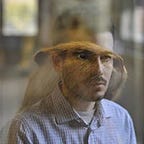The boundaries of an organism (part 2) — Conditional independence
How an organism achieves its independence while interacting with the environment? The Markov blanket provides a possible statistical description.
In part 1 we introduced the concept of Markov blanket, considered as a primary statistical manifestation behind any form of dynamical system emergence, self-organization and dynamic coupling — including the emergence of life (and consequent cognition). Indeed, as claimed by Friston, the emergence of boundaries, i.e. the Markov blanket, is (almost) inevitable in any bio-physical condition and is the prerequisite for any form of living organism [1][2].
For those who are completely clueless about statistics, a quick clarification is needed about two concepts used so far — states and influence between states. Oversimplifying the subject, we can say that given a certain environment, meant as a bounce of bio-chemical elements left free to interact with each other, those elements spontaneously begin to combine and to subdivide into clusters, which means that each portion of elements start to behave as a group, interacting with other groups. This is the initial condition from which the Markov blanket start to emerge. In technical terms, each of these groups of elements can be seen as a node, which consists of all its variables and interactions between those variables. Each of these nodes is expressed by a mathematical function, and the numeric result of this function (its value) will continuously change on the basis of the continuous oscillation of the internal variables. Well, a state (or better a set of states) is the value of that node at a certain point in time.
At this point, we have a node which have different relations-interactions with all the other nodes in the environment, and in order to become a self-organized unity (e.g. a biological organism), it needs to seclude in a durable manner from the rest of the environment (other nodes), thus, making sure that the state of all the “external “nodes will not be able to influence its own state — namely, our node needs to become statistically independent from the environment [2][3].
Now, we know that in nature, a system which completely isolates from the environment is not able exchange energy with it, then not being able to emerge and survive. Moreover, any organism can only survive by getting information from the surround and acting on the external word. In other words, any self-organized system must necessarily be an open (dissipative) thermodynamic system, exchanging energy (and information) with the outside, while resisting the natural tendency to completely dissipate through the environment [1][2].
In order to achieve this condition, our node needs to establish an indirect relation with the environment and it achieves this developing a Markov blanket around itself. Bearing in mind the notions of states and relations (influence-dependency) between them, we can now look at the introductive definition and configuration described at the beginning of the first part of the post (internal, sensory-active, external), visualizing it in terms of nodes and relationships of dependency. An autonomous system, (e.g. an organism) is the system composed of the nodes bounded by the Markov blanket, plus the blanket itself. Namely, coming back to our node developing into an autonomous-independent unity in the environment, as a self-organized system it would be composed of:
- the node itself, representing the internal states
- its parents (the nodes that influence it), representing the sensory states, part of the Markov Blanket
- its children (the nodes influenced by it), representing the active states, part of the Markov Blanket
All the units which are able to influence only the parents of the internal node, and not the rest of the system, are referred as external states, and they are hidden from the internal states by the Markov Blanket, which acts as a mediating interface between internal and external states. Reformulating this in statistical-probabilistic terms — between internal and external states there is a relationship of conditional independence, in which the Markov blanket states are the condition [2][3].
As already mentioned, the one described so far is just a minimal abstract scheme of what a Markov Blanket is. However, in order to understand its primary role in life and cognition, is necessary to acknowledge few key characteristics which a Markov blanket necessarily have, expresses or allows in the context of biological systems. In this regard, in the next post we’re going to deal with the concept of ergodicity, as well as redundancy, mutability, multiplicity of Markov blankets in nature. In this way, we hope to begin to integrate all the abstract notions described so far into a more complex and in-context framework of cognitive agency in terms of adaptive nature of life, finally introducing the theme of free energy minimization and active inference.
[1] Clark, A. How to Knit Your Own Markov Blanket. Philosophy and Predictive Processing, 2017.
[2] Friston, K. Life as we know it. Journal of the Royal Society Interface, 2013.
[3] Palacios, E. R., Razi, A., Parr, T., Kirchhoff, M., & Friston, K.. Biological self-organisation and Markov blankets. BioRxiv, 2017.
